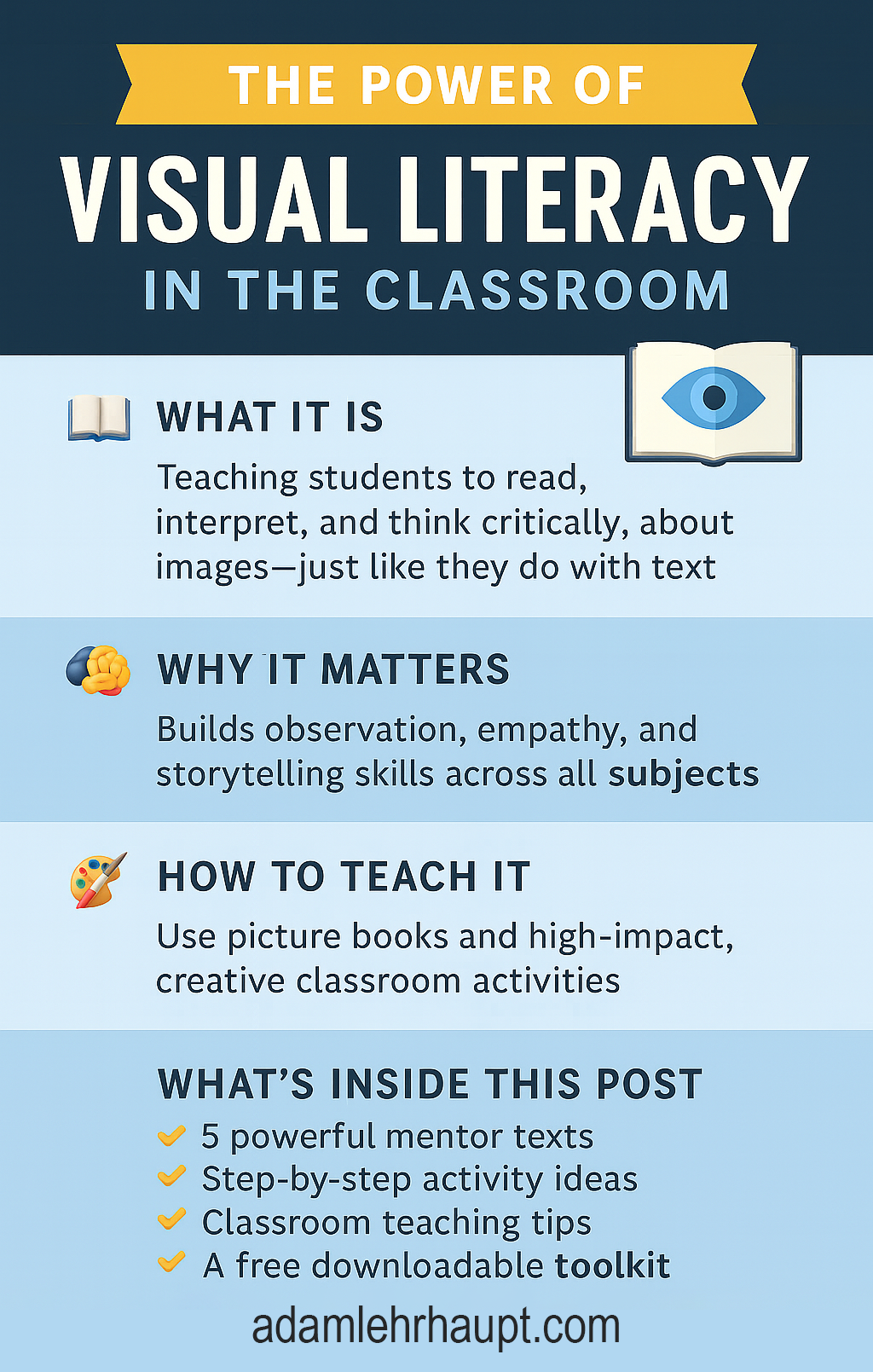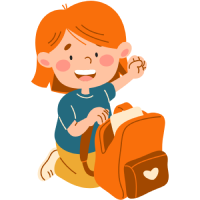A Picture Book Strategy That Teaches Kids to Think Like Readers—and Artists
One time, during a school visit, a student looked me dead in the eye and said:
I like the pictures in your book more than the words.
Did I spiral into writerly despair? Nope. I celebrated that kid. Because honestly? Same.
In today’s picture books, the illustrations are doing a ton of the heavy lifting. If we’re only reading the words aloud, we’re missing half the story—and half the opportunity to boost student learning. That’s where visual literacy in the classroom becomes your secret superpower.
TL;DR: Visual Literacy in the Classroom
- 📖 What it is: Teaching students to read, interpret, and think critically about images—just like they do with text
- 🧠 Why it matters: Builds observation, empathy, and storytelling skills across all subjects
- 🎨 How to teach it: Use picture books and high-impact, creative classroom activities
- 🧰 What’s inside this post:
- 5 powerful mentor texts
- Step-by-step activity ideas
- Classroom teaching tips
- A free downloadable toolkit
- A practical FAQ for educators
🧠 What Is Visual Literacy?
Visual literacy—the ability to understand and interpret visual information—is essential in today’s classrooms. In the classroom, it means helping students “read” illustrations with the same depth and curiosity they bring to text.
And let’s be real: in a world full of memes, emojis, and TikToks with three-second subtitles, this isn’t optional. It’s essential. Want an example of one of my picture books that teaches visual literacy and suspense? Check out I Will Not Eat You here. More on why it fits below.
Teaching visual literacy in the classroom helps students:
- Make inferences based on visual clues
- Build vocabulary and descriptive language
- Understand subtext, tone, and emotional nuance
- Improve storytelling and sequencing
- Develop empathy and critical thinking
It’s also a game-changer for emergent readers, multilingual learners, and reluctant writers—and it gives artistic kids a chance to lead. According to Edutopia, teaching visual literacy improves observation and communication skills in early readers.
📚 Related Resource: Download the free Visual Literacy Toolkit here
Includes: discussion prompts, activity templates, and a curated book list.
📖 Picture Books That Boost Visual Literacy (No Fancy Tech Required)
These five mentor texts are perfect for launching visual literacy activities that get students looking closer, thinking deeper, and expressing themselves with confidence. As always, we try to support shopping at your local indie whenever possible. If that isn’t an option, there are amazon links for these titles below.
1. I Will Not Eat You by Adam Lehrhaupt & Scott Magoon
Visual focus: Shadows, shape, emotional tone
Try this: Pause during the read-aloud. Ask: “What’s happening that the words aren’t telling us?”
Activity: Create a four-panel silent suspense story where the twist is hidden just off-page.
🔗 Grab a copy here
🖼️ Great for: Visual inference, suspense, narrative pacing
2. Lift by Minh Lê, illustrated by Dan Santat
Visual focus: Body language, facial expression, sequence
Try this: Let students narrate what’s happening based only on visuals.
Activity: Students draw a 3-panel comic with no words. Classmates interpret the story aloud.
🖼️ Great for: Perspective-taking, storytelling, collaboration
3. The Rock from the Sky by Jon Klassen
Visual focus: Posture, gesture, deadpan humor
Try this: Have students act out a scene—no dialogue allowed.
Activity: Drama-based tableau: freeze-frame the emotion and explain the mood with movement.
🖼️ Great for: Body language, tone, interpretation
4. Mel Fell by Corey R. Tabor
Visual focus: Direction, movement, page design
Try this: Talk about how vertical space shapes the story.
Activity: Students create a vertical comic: something climbing, floating, falling, or diving.
🖼️ Great for: Visual pacing, kinetic storytelling, book design
5. I Talk Like a River by Jordan Scott, illustrated by Sydney Smith
Visual focus: Mood, emotion, abstract imagery
Try this: Show a spread without words. Ask: “How does this make you feel?”
Activity: Draw a memory using only visuals. Use color, line quality, and spacing to express emotion.
🖼️ Great for: Emotional literacy, SEL integration, symbolism
✅ Teaching Tips for Visual Literacy in the Classroom
- Slow down the page turns. Let students soak in the story.
- Ask open-ended questions. Try “What do you notice?” or “How does that image feel?”
- Use student-led dialogue. Invite peer interpretation—it builds confidence and perspective.
- Anchor with sketching and journaling. Visual notetaking deepens understanding.
- Create a visual literacy wall. Add sketches, questions, and book spreads.
Visual literacy is not just for art class. It’s a doorway to richer comprehension, empathy, and creativity across all subjects. Teaching visual literacy in the classroom also ties beautifully into emotional learning with picture books, where students use emotion to fuel storytelling and art.
📥 Download the Visual Literacy Toolkit
👉 Click here to get your FREE resource pack
What’s inside:
- Visual thinking prompts
- Story panel templates
- Silent comic strip activities
- Booklist with teaching tips
- SEL and ELA standards connections
Use it for sub plans, guided reading extensions, or just a day where you want your students to slow down and look closer.
❓ FAQ: Visual Literacy in the Classroom
What is visual literacy and why does it matter?
Visual literacy is the skill of interpreting visual cues—like illustrations, photos, or symbols. In the classroom, it helps students infer meaning, build vocabulary, and become more reflective, expressive readers and thinkers. It’s especially helpful for diverse learners who may struggle with traditional text.
How do I introduce visual literacy in the classroom to younger students?
Start simple. Ask questions like “What do you notice?” or “What do you think is happening?” Focus on facial expressions, body language, and color. Use books with expressive illustrations and predictable structures.
Can I teach visual literacy without any special materials?
Absolutely. All you need is a good picture book, a blank piece of paper, and time to pause. Let students draw what they feel, notice what others see, and talk about what they think the pictures are trying to say.
What standards does teaching visual literacy in the classroom support?
Q: What standards does this support?
Visual literacy activities align with:
• CCSS.ELA-LITERACY.RL.1.7: Use illustrations and details in a story to describe characters, setting, or events
• CCSS.ELA-LITERACY.SL.2.1: Participate in collaborative conversations
• CASEL SEL Framework: Self-awareness, social awareness, responsible decision-making
Where can I find more classroom-ready lessons like this?
Q: Where can I find more classroom-ready lessons like this?
You can subscribe to my newsletter or explore more activity guides in the resources section. I also offer author visits where we dig into visual storytelling together.
📣 Final Thoughts: Why Visual Literacy Is a Superpower
We teach kids to read books. Let’s also teach them to read pictures.
Because sometimes, the most powerful parts of a story aren’t in the words—they’re in the shadows, the brushstrokes, and the glances we almost miss.
Let’s teach students to notice more, wonder more, and say more—even when the page is quiet.
Want more arts-integration strategies like this? The Kennedy Center’s visual literacy toolkit is a great next step.




